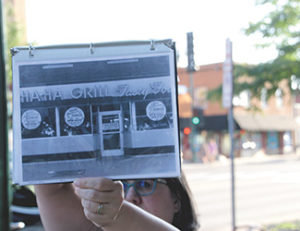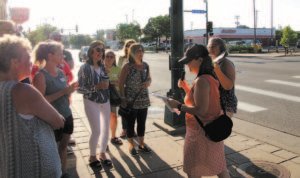Preserve Minneapolis offers historic walking tours of Downtown Longfellow and other locations
 Old and new – Preserve Minneapolis Tour Coordinator Katy Epler holds up a historic photo showing Minnehaha Grill with the building as it is now in the background at Lake and 27th. (Photo by Tesha M. Christensen)[/caption]
Old and new – Preserve Minneapolis Tour Coordinator Katy Epler holds up a historic photo showing Minnehaha Grill with the building as it is now in the background at Lake and 27th. (Photo by Tesha M. Christensen)[/caption] Take a stroll, hear stories, and connect with community
Preserve Minneapolis offers historic walking tours of Downtown Longfellow and other locations
By TESHA M. CHRISTENSEN
On a cooling summer evening, about 20 people gathered at the corner of Lake and Minnehaha with their walking shoes for a Preserve Minneapolis tour.
They spent the next hour and a half walking through Downtown Longfellow, learning about the people and businesses that shaped the area.
The tour began at what is now a large parking lot for Target, Cub and the Minnehaha Center, and also ended there.
“We are starting here because it really represents one of the main reasons this area exists today: this historic industrial complex, which for nearly 100 years, starting in 1873, built things here, and attracted people to jobs that fueled residential, then commercial and retail growth of this area,” explained tour guide Cara Letofsky.
In 1873, a bunch of Minneapolis businessmen, including the city’s first Mayor, Dorilus Morrison, established Minneapolis Harvester Works on the site, and by 1880 it employed about 200 men in industrial manufacturing.
As the year’s grew, the company name changed through various mergers, becoming the Minneapolis Steel and Machinery Company and then Minneapolis-Moline. The company prospered in the 1930s and 1940s as the Lake St. plant specialized in the production of tractors and engines, pointed out Letofsky, who also drew on information gathered by Eric Hart, Iric Nathanson, and other members of the Longfellow History Project during her tour.
 Weaving stories of then and now, Cara Letofsky leads a tour in Downtown Longfellow on Aug. 8, 2019, walking in a 6-block radius of Lake and Minnehaha. The AutoZone was once home to three buildings of the Longfellow school campus. All were torn down. (Photo by Tesha M. Christensen)
Weaving stories of then and now, Cara Letofsky leads a tour in Downtown Longfellow on Aug. 8, 2019, walking in a 6-block radius of Lake and Minnehaha. The AutoZone was once home to three buildings of the Longfellow school campus. All were torn down. (Photo by Tesha M. Christensen)There were 20 shops in separate buildings at the sprawling plant at its peak, including an engineering department where the original Jeep was designed, located in the building at 2841-47 26th Ave. S., the last remaining building of the Moline campus (now the 7-Sigma building).
At its peak, the site employed 6,000 people.
White Motor Company of Lansing, Mich., acquired Minneapolis-Moline in 1962 and decided to shutter the plant in 1972, laying off the remaining 1,300 workers. When it couldn’t find a buyer, it demolished all the buildings on the site.
“The city then purchased the land and helped redevelop it into a retail mall, anchored by Target’s first inner-city store,” said Letofsky.
Toro gets its start
Nearby, the Toro Manufacturing Company had its start, setting up shop in an old two-story Victorian home at 3042 Snelling Ave. S. The economic depression after World War I threatened to close Toro for good.
Members of the Minikahda Club, who were looking for a better way to keep up their golf course, approached the company. Toro rose to the challenge and began designing lawn mowing equipment. The firm grew on Snelling Ave., eventually occupying more than 70,000 square feet in various buildings and employing 400 people before moving to a new Bloomington plant in 1962.
Large buildings rise 1909-1914
Many of the familiar buildings in Downtown Longfellow were built between 1909 and 1914, including the Coliseum, Lake Street Bank, and International Order of Odd Fellows, with the Fire Station No. 21 preceding it in 1894. Others have since been torn down including the original three-building campus of the Longfellow School (current AutoZone/Aldi site) and Lake Theater.
According to one report, about two-thirds of the residential areas around 27th and Lake had been built by 1911, said Letofsky, and 90% by the end of the 1920s.
Foot trail to transportation corridor
“The story of the Minnehaha-Hiawatha Ave. corridor and its evolution from humble beginnings as a foot trail running between Fort Snelling and the Falls of St. Anthony to the current multi-modal transit corridor that crosses South Minneapolis diagonally, bringing people from downtown Minneapolis to the Minneapolis-Saint Paul International Airport and Mall of America, is the story of how evolving transit modes also change the urban landscape,” pointed out Letofsky.
In 1865 the Minneapolis and Cedar Valley Railroad Company – forerunner to the Chicago, Milwaukee and St. Paul railroad – chose to lay its railroad tracks parallel to Fort Snelling Road.
In 1886, the streetcar line from downtown reached Lake St. along 27th Ave., then the final piece of the neighborhood framework came in 1888 when Lake Street was chosen as the route on which to construct the cross-river bridge linking Minneapolis and St. Paul.
As residents and jobs began moving out to the suburbs, the streetcars were pulled up in 1954 in favor of buses and cars. By 1933, Hiawatha Ave. was designated as a segment of State Highway 55, which extended from Hastings to Tenney, Minn. Hundreds of homes and businesses were demolished in the 1960s for an 8-lane freeway, but intense neighborhood opposition arose in the 1970s. The freeway plan was abandoned in favor of a four-lane roadway with a light rail transit (LRT) system that was approved in the mid-1980s. The lightrail line began operating in 2004.
Sharing stories
Cara Letofsky is fascinated about how cities grow and change and the stories behind why our communities look how they do.
“It’s fun to do the research on local neighborhoods, then put the changes that happened in the larger historical context. How was this neighborhood impacted by the Great Depression? By Post-war suburban growth? Reinvestment in urban areas? Doing tours allows me to share these same stories of our own community to a broader audience who want to understand how their own communities came to be,” observed Letofsky.
The Cooper neighborhood resident who grew up in South Minneapolis had been a fan of walking tours and Preserve Minneapolis for years. She began as a tour guide in 2012 just as the Lake Street Council’s Museum in the Streets tour panels were being installed. Three tours were given that summer: in Uptown, in Midtown, and at 27th and Lake. (See sidebar)
Since then she has led at least one tour a year, bringing her longtime knowledge of the area and work experience into her tours.
A past board member and president of the Hennepin History Museum, Letofsky runs her own consulting firm, Mill City Consulting, partnering with nonprofits and other community efforts on community-improving projects. Her background includes working for Mayor R.T. Rybak, representing District 8 on the Metropolitan Council from 2015-2019,and founding the City of Lakes Community Land Trust in 2002.
Letofsky has also led the “Dinkytown: Forever Young” tour, and supported Shari Albers’ great tour of the Washburn-Fair Oaks Historic District, the neighborhood around Mia and the Hennepin History Museum. Last year she partnered with the Mapping Prejudice Project and Tina Burnside (now of the Minnesota African American Heritage Museum and Gallery) on an extremely popular bus tour with Preserve Minneapolis titled, “Housing Discrimination Revealed: History of Race and Real Estate in Minneapolis.”
Preserve Minneapolis was founded in 2003. The non-profit is dedicated to improving the quality of life in Minneapolis by recognizing, preserving, and revitalizing the architectural and related cultural resources of the city of Minneapolis.
Past helps to ID solutions
“As a history enthusiast, I believe understanding what came before us helps us better understand what is happening today, and can help us identify real solutions to today’s challenges,” remarked Letofsky.
“When it comes to neighborhood walking tours, they are valuable in that they not only get people out enjoying their community, but they also teach people about what came before them, and help people appreciate their community more.
“I mean, don’t you have more appreciation of the Minnehaha Mall parking lot more now that you know it used to house a factory that employed up to 6,000 people?”
~ Contact editor at tesha@longfellownokomismessenger.com
Join a tour
>> Milwaukee Avenue Historic District Walking Tour, Saturday, Sept. 14, 11 a.m. - 12:30 p.m., $12
>> Murder and Mayhem: Pioneers and Soldiers Memorial Cemetery Walking Tour, Sunday, Sept. 15 9:30-11:30 a.,m., $12
>> Neighborhood Movie Theaters Walking Tour, Calhoun Square, Sat, Sep 21 2-4 p.m., $12
>>The Lost Gateway District of Minneapolis Walking Tour, Sunday, Sept. 22 9:30-11:30 a.m., $12
>> Nicollet Island Walking Tour, Saturday, Sept. 28 10 a.m - noon, $12
More at http://www.preserveminneapolis.org/
Stroll for free down Lake St.
>> Residents can take the Museum in the Street tour at three locations along Lake St. at any time by strolling down the streets at their own pace.
>> There are three bilingual heritage-discovery walks with 15-20 stopping points: Uptown: Minneapolis’ Lake District, Midtown: A Place to Call Home, and 27th and Lake: Industry and Transportation Infrastructure.
>> This tour helps foster a sense of historical identity while educating; encouraging the preservation of local historic sites; and promoting knowledge of the stories, events, and traditions of Lake St.
Maps and more at https://www.lakestreetcouncil.org/programs/museum-in-the-streets
Comments
No comments on this item Please log in to comment by clicking here